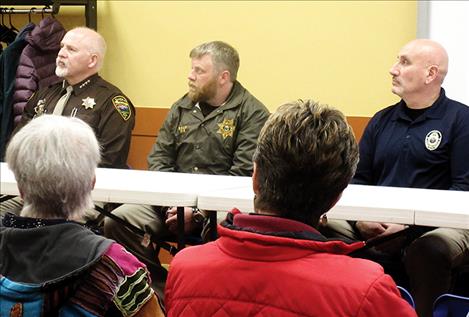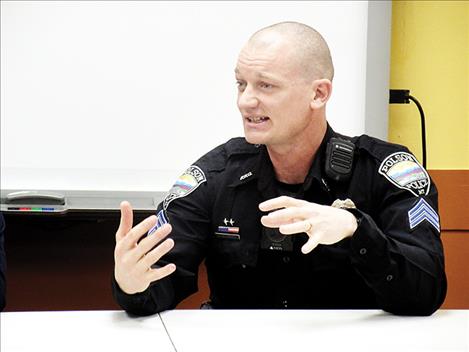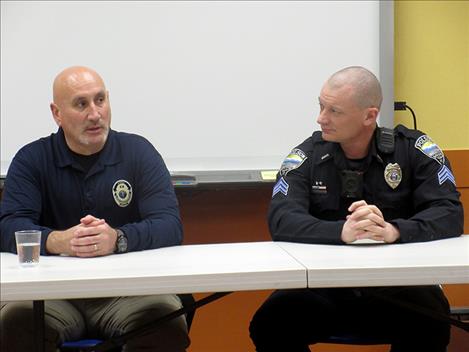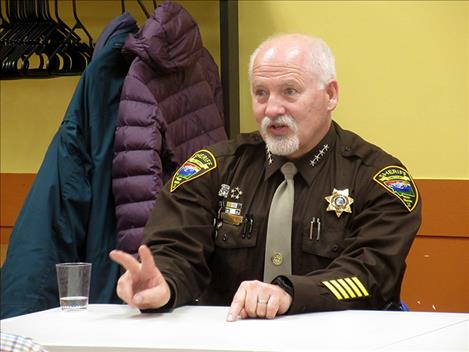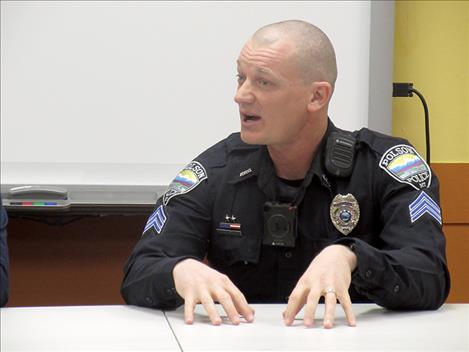Law enforcement officials speak on local drug activity, solutions
Hey savvy news reader! Thanks for choosing local.
You are now reading
1 of 3 free articles.
POLSON – Community members got answers last week to a wide range of questions on drug use in the county directly from those who enforce drug laws - from which drugs are used to what is being done to treat addiction.
The event featured a panel of officers from the Confederated Salish and Kootenai Tribal Police, the Lake County Sheriff’s Office and the Polson Police Department.
Craig McClure, chair of the Lake County Democrats, organized the panel. The event, held at North Lake County Public Library, drew about 20 people. He said the event fulfilled one of the organization’s central aims.
“One of our biggest concerns is educating the public on issues relevant to Lake County,” McClure said. “It’s important for our citizens to be aware.”
Having representatives from three law enforcement agencies that work in Polson allowed attendees to get a deep perspective on drug issues in the area. “We’re all different agencies with different perspectives but the same goals,” said Levi Read, Lake County Sheriff’s Office lieutenant.
First, the officials were asked how many drugs are sold and used in the county. CSKT Tribal Police Chief Craige Couture said there had been recent arrests of people involved in gang activity and large-scale drug dealing in the area.
Couture said the “number one” drug in the area is methamphetamine. The drug is shipped from Mexico to Washington and then moved from Washington into the Mission Valley. Couture said the demand for meth in the area means drug dealers can profit greatly from drugs they buy close to the Mexico border and transport to Montana.
According to Couture, the demographics of drug users and dealers in the area is variable. He said he has seen people from age 12 to age 70 using and dealing drugs in the area. According to Couture, the second most prevalent drug used in the area is marijuana. The officials said prescription drugs and heroin are also used, to a lesser extent, in the area.
Couture said most people who commit drug offenses would do so again. “Less than 20 percent of the people take up 80 percent of my resources,” he said of law enforcement funding and time.
Sheriff Don Bell wanted to make sure the community knew that though drug abuse is a serious problem in Lake County, it shouldn’t be seen as reducing the value of the community. It’s a problem that is playing out across the country, he said.
When asked about providing treatment to those addicted to drugs, Bell said the county’s drug courts have a significant impact. The programs are an alternative to incarceration for those who have committed nonviolent crimes. Instead of serving time, the drug court participants must commit to staying clean and working to heal from their addictions.
“It’s very strict and regimented. We are having a really good success rate,” Bell said.
The panel was asked whether a larger treatment center for mental illness and addiction could be developed in Lake County. Couture said that though it’s needed, there’s no funding to make it happen.
Couture said he sees a lot of drug offenders who are mentally ill. The jail can’t provide the services they need, but there’s nowhere else to take them. Bell said the Montana State Hospital in Warm Springs is not able to serve all those who need mental healthcare. The hospital is the only public psychiatric hospital in the state.
Jail facilities were another topic of conversation. Bell said that the county jail has been full during his entire career. About 80 percent of people who go to jail once will return, he said. He cited long wait times to see a counselor as a reason for high rates of recidivism.
“They need the right amount of counseling to deal with the environment in their life that makes them turn to drugs,” Read said.
In addition, the Lake County Jail doesn’t have ample space for inmates to visit with doctors or attorneys. According to Bell, the public needs to understand the importance of updated jail facilities so they’ll be willing to contribute tax dollars to fund it. Couture said a new jail isn’t the only solution. “We can’t build a jail big enough to solve this (drug) problem.” He advocated for increased drug rehabilitation counseling.
Sergeant George Simpson of the Polson Police Department said his department had “shifted from the war on drugs to a war on children involved in drugs.” The department has collaborated with other law enforcement officials and Child Protective Services to get children out of homes where drugs are being used or sold.
Simpson encouraged community members to report suspicious activity. “The best intel we get comes from the community and neighbors,” he said.
Jackie Ladner attended the forum because she was interested in learning about drug activity among young people, especially in local schools. Couture said there is drug activity in the schools. Most of it is a result of children who gain access to drugs through their addicted parents.
Overall, the officials said they want to help those who are struggling with addiction. Simpson said when he visits a home on a search warrant he leaves resources so that those who are addicted can get counseling or help with recovery. When asked about laws that would protect addicts from legal repercussions if they were seeking treatment, Simpson said, “If we get a call, we’ll help them. We don’t need a legislator to tell us to do that.”















